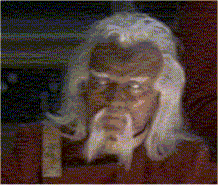
Of great interest to many is the Ketian religion, probably not surprising because of their recent expansive tendencies into areas of Veluna, Bissel and even western Furyundy.
Their religion is unique in that their Gods appeared to them before the people actually worshipped them. Circa 200 years before the Age of Sorrows which begins with the founding of the Great Kingdom, or 200 years before the end of the Age of Legends, it is believed that nomadic tribes inhabited the lands of Ket and the Paynims. Most likely, they migrated north from the old Balcuni-Sulouise Empire before it was destroyed by the Reign of Colorless Fire (6).
Apparently, the Ketian 'gods' appeared to these nomadic herders/tribesmen and forced worship upon them. It is all but certain that these 'entities' are of demonic origin wishing to hold sway over parts, if not all, of the Prime Material Plane. The Ketian gods gave unto their subjects all manner of devices and taught them building skills and strange arcane arts. Little else is known of the culture because of their secretive and private ways. Their great pyramids prevent any use of magic to scry, travel, see, hear, or otherwise learn about anything going on in the city, and anyone travelling to Ket is detained, and presumably converted because few are ever seen again.
from A Treatise of the Current Religions of Oerth by the Scholarly Mage Eof Matain, the Bigby Chair of The University of Greyhawk, Greyhawk City
Trade from Ket has stopped since the beginning of the Holy War just two years before the battle at Tovag Baragu (YR578 Age of Sorrows). During the Final Battle, Ketian Priest-Princes wielded three swords of power: Coinspinner, the Sword of Luck, Townsaver, the Sword of Fury, and the MINDSword, the sword that awes and beguiles all who have eyes when the sword is held aloft. Brother Romag, the evil manipulator, gouged out his own eyes before entering Ket, where he quickly became a special advisor to the Priest-King and, after Finerio McBain slew Romag with the vengeance power of Maria, his sword, Romag became a saint of the Ketian religion. The Ketian people are now influenced by a combination of their foreign gods and by the influence of Romag.
Wayfinder, the Sword of Wisdom, and Dragonslicer, the Sword of Heroes, were also given to the Champions of Sophora by Mandrake Mandragoran, who believed in the stories of Ragnarak (the choice between gods) that were being spread by agents of the Dark One. Mandrake asked that those swords be dedicated to the Ketian religion during the final battle if the decision of Ragnarak were made. Fortunately, the Final Battle was not about choosing the gods, and all of Oerth did not fall under Ketian influence.
It is because the MINDsword
fell to Ket during the Dark Times (as
well as their special magics that are resistant to any other magic on
Oerth--Archmage Sultan Zyntax
even
believes that they may be using a combination of magic and technology)
that Ketians were able to conquer so much territory and that Rahasia Alvere
convinced the Theocracy
of the Pale to declare Holy War
against Ket. From the people who have survived Ketian attacks,
especially since the end of the Dark Times and the loss of the powers
of the MINDsword, reports describe great metal birds that hover as well
as fly and shoot missiles, fireballs, and meteor swarms from their
beaks. Their knights wear great, impenetrable armor, often with helms
in the shape of the heads of the animals sacred to their gods. Ketian
armies are often accompanied by great phoenixes who also attack with
fire. Ketians in Ket had to work to overthrow the barbarians.